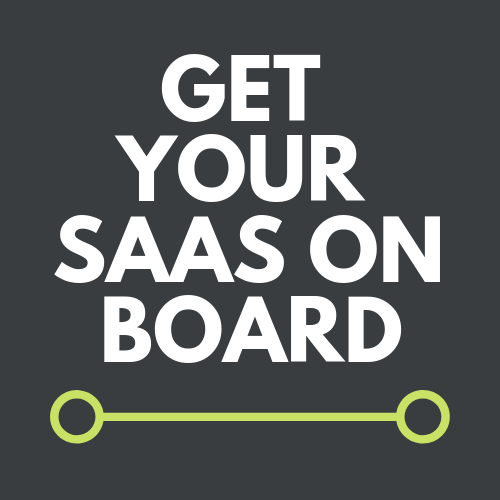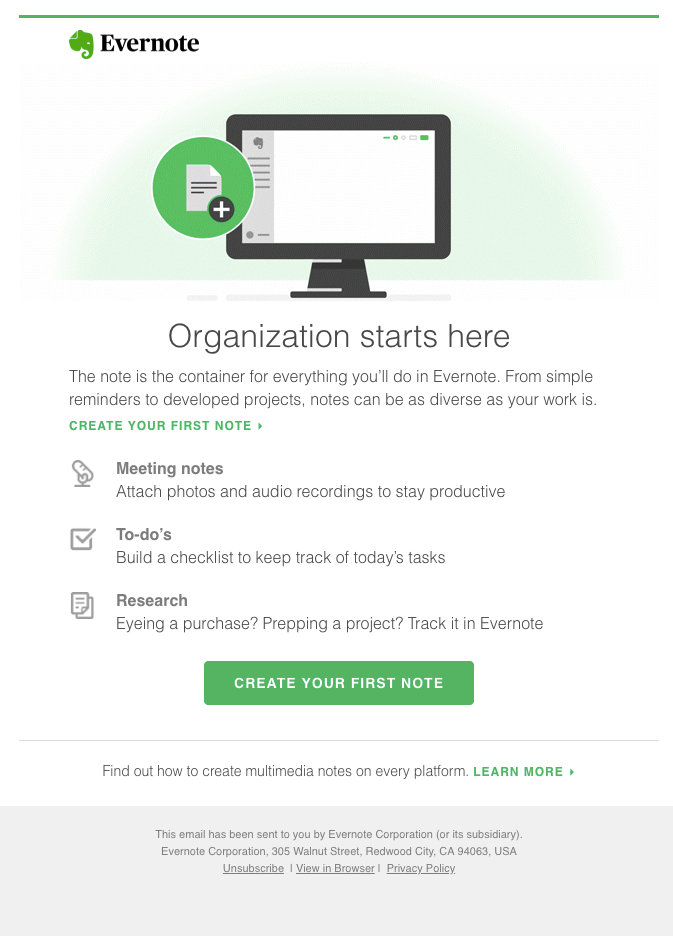Evernote Basic Onboarding Email Breakdown
SaaS onboarding is like dating. And the free trial period is the first date.
Let me explain.
There was at least some initial interest and effort that led the parties to this point. However, attention spans are short. Since an emotional attachment hasn’t been built yet, deal breakers may be lurking around every corner for the trial user. There’s also the chance that onboarding will just be “okay.” It wasn’t a bad date, but it also wasn’t great. And who has time for that?
The days when a new user is getting acquainted with your SaaS product are critical. I won’t try to scare you with too much talk of skyrocketing churn rates, but know that onboarding is essential for building a user’s relationship with your brand.
What makes a good SaaS onboarding series though? There are a lot of elements and options to choose from, and it varies between each company. However, it’s still useful to see real-world examples. Today I’ll be taking a look at the onboarding email series for Evernote Basic. This is their free plan, so technically there’s no need for a “free trial.” Even so, attention is spent to onboarding new users.
Series Overview
As soon as I signed up for Evernote Basic I technically became a customer, and their emails will continue on without interruption. There isn’t a set “free trial” period for the Basic plan, but for this post, I looked at the emails from the first 14 days.
Day 1: Welcome
Subject Line: Welcome to Evernote!
Sender Name: Evernote
Send Time: Immediately after signup
Objective/Content: Introduce users to the option to download the Evernote app, present a few desktop features, and offer an upgrade to premium.
CTA: Download the app, learn more about desktop features, and upgrade to premium
Strengths:
First of all, this is about as clear of a welcome email you could see in your inbox. The email was sent immediately, the sender name is just what you’d expect, and the subject line is straightforward.
What to learn from it:
Send an email immediately that includes your brand name and a simple, clear welcome
Weaknesses:
This email is asking readers to go in a few different directions. First, the hero image at the top features a CTA to download Evernote on your phone. Then, the content below calls out desktop features. Next, there’s a CTA to upgrade to premium right away. The email comes full circle with another CTA to download the Evernote app at the bottom.
To be honest, I’m also a bit confused by the headline “don’t let your notes get lonely.”
What to learn from it:
Laying out options for new users isn’t necessarily bad, but how you organize the information matters. In this scenario, the content could have been laid out as a step by step guide.
It’s also important to think about onboarding emails in terms of what core actions you want customers to take. Which will make a more lasting impact or create a habit faster; downloading the app or exploring desktop features?
Day 2: Introduce the Building Block
Subject Line: What is a note?
Sender Name: Evernote Team
Send Time: Day 2, 9:30 AM CST
Objective/Content: Introduce new users to a core feature of Evernote
CTA: “Create your first note”
Strengths:
This email from Evernote is what onboarding is all about. SaaS products are loaded with features and capabilities that are continually changing and improving. That’s great for existing users, but it’s overwhelming for new users.
Onboarding needs to focus on getting a user to take tiny steps. Instead of showing new users how to manage an entire project, Evernote has started with the essential building block of its service. The email focuses on one action and is short and sweet.
The subject line is also effective. Everyone has taken notes in their lives, so I’m sure most people feel they have a solid understanding of what it is. By seeing the question “what is a note?”, the reader has their perspective challenged.
Finally, note the send time (#UnintentionalPun). I signed up within the central time zone. However, a 9:30 AM CST send time lands the email in the inbox early-to-mid morning for most people. Perhaps the reader is taking a break from other tasks to check email and is therefore open to spending a few moments on the platform.
What to learn from it: The welcome email says “hello, this is who we are” while the second email gets down to business. There are two elements to an effective first “baby step” email.
First, the email should focus on a single features. What’s the one “building block” that a user will use in a majority of the tasks they complete on your platform? Focus on that one.
Second, the email needs to be short. Sure attention spans may be shortening, but what else is great about a quick email? You don’t feel like it’s wasted a bunch of your time. Therefore, you have free time to spend! Readers should think that “since reading this onboarding email didn’t take me long, I’ll just click on this nice big CTA button and play around with this tiny step for a few minutes.” Bingo, they’re taking the first steps towards establishing a habit.
Day 3: Problem Solver
Subject Line: The many ways to search in Evernote
Sender Name: Evernote Team
Send Time: Day 3, 9:36 AM CST
Objective/Content: Get users to try out search, plus information on an upgrade to Evernote Business
CTA: “Try out search” and learn more about Evernote Business
Strengths:
One of the ways to turn your SaaS product into a habitual tool for new users is to remove barriers and solve problems. That sounds obvious, but it’s worth stating nonetheless. As new users test out a product (or even see you talk about features), there will likely be doubts in their mind. No matter how helpful it may be in the long run, creating new habits is hard. Plus, excuses are really easy to make. This email works because it takes a possible excuse and shuts it down. In the case of most onboarding, the hurdle is changing your workflow. No matter how inefficient it may be, a routine is a routine. A user is familiar with how and where they keep notes and documents now. But how will they possibly keep track of them all if they implement an entirely new tool? A simple search bar. Easy to use and familiar, it removes the barrier of learning a new organization system or work management platform.
This email also has an apparent connection to their upgrade CTA. It doesn’t just say “upgrade to premium to get access to more shiny bells and whistles!” It expands on the solution above and shows it in a broader context. If it’s a hurdle the reader had in mind, the CTA catches their eye. If not, it’s easy to just focus on the main CTA.
What to learn from it:
Solve a user’s problem. I don’t mean by mentioning all of the shiny bells and whistles your product has, either. Think about the excuses they could make to avoid implementing your tool, and then show them why they don’t need to worry about that.
Ready to create or upgrade your SaaS onboarding email series? Download What to Include in a 14-Day Onboarding Email Series (And When to Send Each Email) here.






